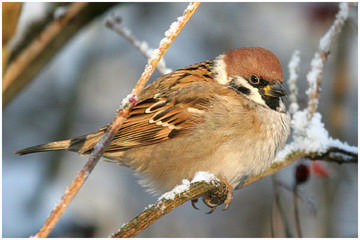
Tree Sparrow © David Tolliday
Most adult Tree Sparrows are sedentary, whilst the young birds disperse, avoiding inbreeding by moving a few km. There is a small reduction in the number of tetrads occupied from the breeding season to winter – 321 to 276 – which could be attributed to some birds deserting their breeding areas in the formation of winter flocks. 103 tetrads had birds in the breeding season but not in winter, with 58 where they were found in winter only. There is no significant change in habitat codes recorded between breeding and winter seasons, with 66% of winter records from farmland and 30% from human sites (overwhelmingly rural), and a handful from woodland and scrub.
All of them seem to join winter flocks, from a few to several hundred birds in size. Half of the reported groups in this winter Atlas were of five birds or fewer while there were seven three-figure flocks, all in the south of the county. The largest, estimated at 300 birds in 2005/ 06 and 200 birds in 2006/ 07, fed on strips of setaside and stubble in the area north of Combermere, covering four adjacent tetrads (SJ54X/ Y/ SJ64C/ D). A flock of 220 birds spent the winter of 2005/ 06 feeding on stubble and game cover including quinoa at Warmingham (SJ76A). Nationally, a major decline – a drop by a factor of three – has been noted in the sizes of winter flocks recorded in 1980-95 compared to 1965-79 (Shrubb (2003)).
It is hard to deduce their former status in Cheshire and Wirral. Previous Cheshire ornithologists wrote little about Tree Sparrows in winter, but Coward and Oldham (1910) commented that they were frequently seen in farmyards or by the roadside in company with House Sparrows, Chaffinches and Yellowhammers. Perhaps the annual county bird reports tell a story. In the 1960s the species was ignored, along with all others that were thought to be common; the reports from 1975 to 1977 list a few large flocks, up to several hundred strong; but by 1982 there were ‘few large flocks noted’ and in 1983 all flocks larger than 20 birds were listed (CWBRs).
Although Tree Sparrows join feeding flocks of other seed-eaters, they tend to stay close to hedges or other suitable cover, and hedgeless fields and the centres of large fields are left to the finches and buntings. Undisturbed flocks frequently move in waves, the birds at the back of the flock flying forward to take up position at the front. They feed in bouts, gorging themselves then retreating to cover where they preen and digest their food.
Tree Sparrows eat some farmland grain, but much less than House Sparrows do: they tend to specialise on smaller seeds such as grasses and annual weeds such as goosefoot and chickweed. They also like oil-rich seeds including sunflowers and rape. In extensive areas of planted wildbird seed crops on farmland near Broxton, I have found that Tree Sparrows ignore the areas dominated by kale and triticale and only frequent plots containing quinoa and millet: birds caught for ringing have had their crops full of these small seeds. However, observations elsewhere (Perkins et al 2007) have found different results, the authors commenting that ‘For species with a diverse diet, such as Tree Sparrow, food preference may vary between populations in different locations, due to learned behaviour and adaptation to locally abundant seed types.’
They form communal roosts, especially in thick hedgerows, but in hard weather many birds roost in holes, perhaps those that have been, or will become, their nesting site. Just four roosts were reported from Atlas fieldwork, in adjacent tetrads near Buerton (SJ64V and W), and near Weston (SJ75F and K).
Sponsored by Alan and Judith Straw

